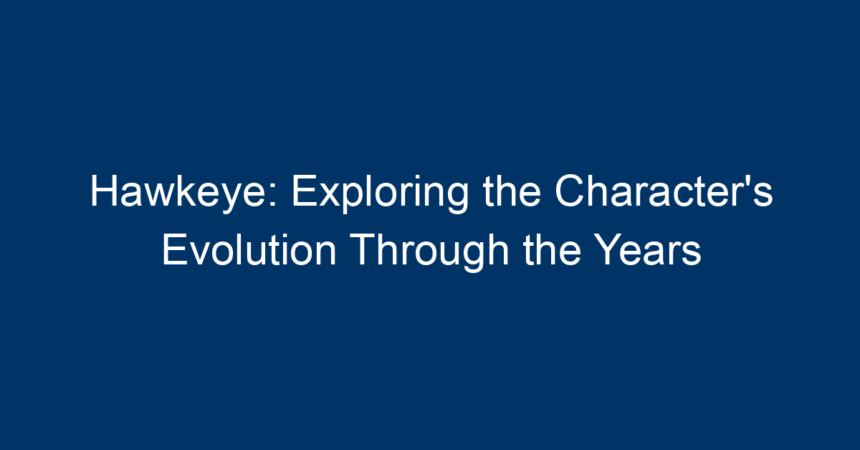Hawkeye, one of Marvel Comics’ most beloved characters, has captivated audiences for decades. Known for his exceptional archery skills, quick wit, and complex personality, Hawkeye’s journey from a misunderstood villain to a key member of the Avengers is a testament to the depth and versatility of comic book storytelling. This article delves into the character’s evolution, exploring his origins, significant story arcs, and impact on the Marvel Universe.
The Origins of Hawkeye
Hawkeye, whose real name is Clint Barton, made his first appearance in Tales of Suspense #57 in 1964. Created by writer Stan Lee and artist Don Heck, Barton was introduced as a skilled archer who initially clashed with Iron Man. His origin story, however, is far more compelling. As an orphaned child, he grew up in a circus, where he honed his archery skills, learned acrobatics, and developed a knack for trick arrows. This fascinating background laid the foundation for one of Marvel’s most relatable heroes.
Early Years: From Villain to Hero
Clint’s journey was not straightforward. Initially portrayed as an antagonist, Hawkeye’s character began to evolve when he joined forces with the Avengers in Avengers #16 (1965). His transition from villain to hero resonated with fans, illustrating how complex motivations can lead to redemption. This transformation is a common theme in Marvel narratives, emphasizing that heroes can emerge from the darkest of places.
The Evolution of Hawkeye’s Character
The 1970s: Seeking Redemption
The 1970s marked a significant period for Hawkeye, where his character depth started to expand. Storylines introduced his internal conflicts as he struggled to balance his identity as a hero with his past. One of the standout arcs during this time is the Avengers storyline, where Hawkeye grapples with his role in the team and his relationships with other members, especially with Black Widow. Their partnership added complexity to his character, highlighting the themes of love and sacrifice.
Hawkeye’s Solo Adventures
During the late 70s and early 80s, Hawkeye earned his first solo title in Hawkeye #1 (1983). This series showcased his unique personality traits, allowing fans to connect with him outside of the Avengers’ dynamic. The stories delved into his personal life, revealing his struggles, aspirations, and sense of humor—a blend that defines the essence of Hawkeye.
The 1990s: A Shift in Tone
The 1990s represented a turning point for Hawkeye. The rise of darker, edgier storytelling aligned with his character’s challenges, often portraying him dealing with loss. One of the defining moments came during the Onslaught saga, where he faced one of his greatest tragedies. This period emphasized Hawkeye’s mortality, making him more relatable and human.
Entering the New Millennium
The 2000s saw Hawkeye undergo a significant transformation in both character and visual representation. The Avengers: Disassembled storyline, penned by Brian Michael Bendis, left a lasting impact. Hawkeye bravely faced down overwhelming odds but ultimately met a tragic end, leading to shocking repercussions throughout the Marvel Universe.
The Rise of Kate Bishop
With Clint’s death in Avengers: Disassembled, a new archer emerged—Kate Bishop. Introduced in Young Avengers #1 (2005), Kate quickly became a fan favorite. She not only inherited Hawkeye’s mantle but also expanded the character’s legacy. The introduction of Kate Bishop provided a fresh perspective on the Hawkeye persona, emphasizing themes of mentorship and teamwork.
The Impact of the Hawkeye Series
In 2012, Matt Fraction’s Hawkeye comic series became a landmark for the character. It brilliantly showcased Hawkeye’s everyday life, blending humor with heartfelt moments. The series focused on Clint’s personal battles and relationships, particularly with Kate Bishop. This portrayal solidified Hawkeye’s place in the Marvel Universe and won numerous awards, including the Eisner Award for Best Continued Series.
Hawkeye in the Marvel Cinematic Universe
The journey of Hawkeye transcended comics and made a formidable impact in the Marvel Cinematic Universe (MCU). Portrayed by Jeremy Renner, Hawkeye first appeared in Thor (2011) and gained prominence in The Avengers (2012). His portrayal resonated with audiences as a relatable hero among the super-powered characters.
The Role of Family
A fascinating aspect of Hawkeye’s character in the MCU is his family. The films depict him as a dedicated husband and father, showcasing a humane side that contrasts with other characters. This family dynamic adds depth to his character, emphasizing that the responsibilities of heroes often extend beyond the battlefield.
The Disney+ Series: A New Chapter
The release of the Hawkeye Disney+ series in late 2021 marked a new chapter in Clint Barton’s journey. The show explored his life after the events of Avengers: Endgame, addressing his struggles with grief, guilt, and the desire to protect his loved ones. The dynamic between Clint and Kate Bishop highlights mentorship, legacy, and the passing of the torch—a theme that aligns with the evolving nature of superhero narratives.
The Legacy and Future of Hawkeye
Hawkeye’s evolution reflects broader changes in both comic storytelling and popular culture. His character has grown from a misunderstood villain to a relatable hero, symbolizing resilience and the complexities of human emotions.
Continuing Relevance
As the Marvel Universe expands, Hawkeye remains relevant. His story resonates with audiences who appreciate the value of perseverance and redemption. The growth of characters like Kate Bishop ensures that Hawkeye’s legacy will continue to be explored through new lenses.
Actionable Insights for Fans
For those looking to explore Hawkeye’s character further, consider the following:
-
Read the Comics: Start with essential arcs like Hawkeye by Matt Fraction, Young Avengers, and Avengers stories to appreciate the depth of his character.
-
Watch the MCU: Follow Clint’s journey through the Marvel Cinematic Universe. His appearances in films and the new Hawkeye series provide context for his evolution.
- Explore Fan Communities: Engage with fans through forums, social media, and conventions. These platforms offer insights and discussions that deepen your understanding of Hawkeye and his impact on pop culture.
Conclusion
Hawkeye’s evolution is more than just a character arc; it’s a portrayal of resilience, redemption, and the enduring human spirit. His journey from a conflicted antagonist to a beloved hero demonstrates the power of storytelling in comics and film. As Hawkeye continues to grow and adapt, he remains a vital part of the Marvel Universe, inspiring new generations of fans to embrace the complexities of heroism. Whether through comics or the screen, Hawkeye is truly a character for the ages.




